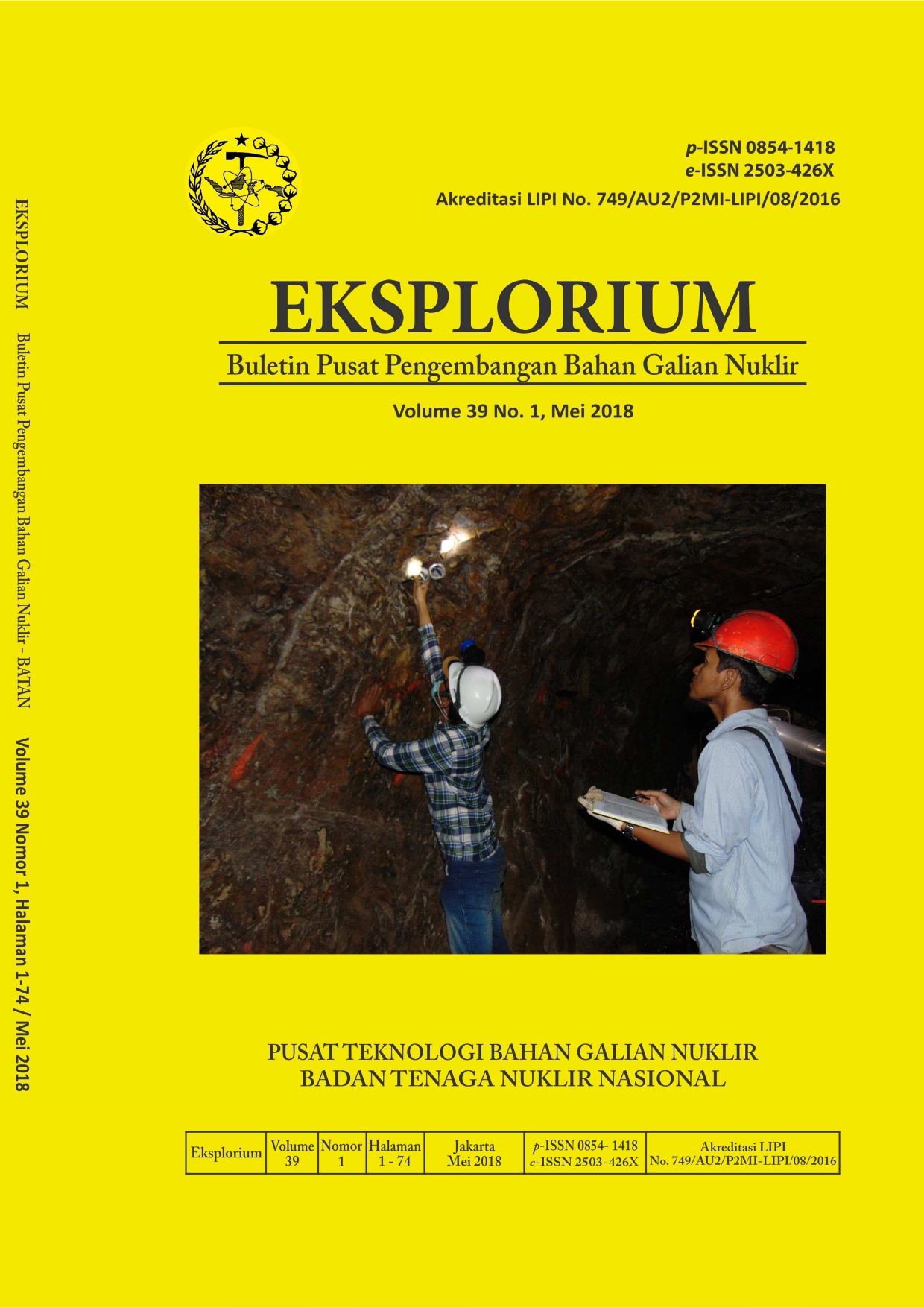Pelindian Natrium Zirkonat Menggunakan Asam Klorida Secara Catu
Main Article Content
Abstract
Research on zircone processing technology has been continued to follow industrial market needed. Treatment of sodium zirconate with leaching process using hydrochloric acid as solvent has been conducted. The aim of the study is to evaluate the effect of grain size, temperature, and speed of stirring on the extracted zircon. The research starting with introduced the solvent (chloride acid 4 N) into the reactor, then heated while stirring. The feed with a certain grain size was introduced into the reactor. The temperature and stirring conditions were kept steady. Once the operating conditions are reached, the process is stopped and then filtered. The results with XRF analysis showed that the optimum process conditions were achieved on 90 μm grain size, the temperature of 80oC, and stirring speed of 200 rpm. The amount of zircon that taken out were 84.50% on this conditions.
Article Details

This work is licensed under a Creative Commons Attribution-ShareAlike 4.0 International License.
1. Introduction
By using or sharing content from EKSPLORIUM - Buletin Pusat Pengembangan Bahan Galian Nuklir ("the Journal"), you agree to follow these Terms and Conditions. The Journal's content is licensed under the Creative Commons Attribution-NonCommercial-ShareAlike (CC BY-NC-SA) license. If you do not agree to these terms, please do not use the content.
2. How You Can Use the Content
-
Share: You can copy, share, and distribute the work, but only for non-commercial purposes.
-
Adapt: You can change, remix, or build on the work, as long as it is for non-commercial purposes and you share it under the same license (CC BY-NC-SA).
3. Attribution (Giving Credit)
When you use or share the content, you must:
-
Give proper credit to the author(s).
-
Mention the title of the work and the journal name.
-
Provide a link to the license (https://creativecommons.org/licenses/by-nc-sa/4.0/).
-
Indicate if you made any changes to the work.
4. Non-Commercial Use
You cannot use the work to make money or for any commercial activities. For example, you cannot sell or use the content in advertisements.
If you want to use the content for commercial purposes, you need to get permission from the author(s) or the publisher.
5. ShareAlike
If you make changes to the content (like creating a new version or remixing it), you must share your new version under the same CC BY-NC-SA license.
6. Exclusions
Some materials in the Journal may have different licenses or restrictions, such as third-party content (like images or datasets). You must respect the rules for those materials.
7. No Warranty
The content is provided "as is." The authors and publisher do not guarantee that the content is error-free or suitable for any specific purpose. Use the content at your own risk.
8. Modifications and Withdrawal of Content
The publisher and authors can update or remove content at any time. If content is removed, the previous versions will still follow these terms.
9. Ethical Use
You must use the content ethically and follow all relevant laws. This includes properly citing the original authors and not misusing the content.
10. Legal Compliance
You are responsible for making sure your use of the content follows the laws of your country. If you believe content violates your rights, please contact us.
11. Changes to Terms
These Terms and Conditions may be updated from time to time. Any changes will be posted on the Journal's website.
12. Contact Information
For questions about these Terms or for permission to use content commercially, please contact us at:
-
Email: eksplorium@brin.go.id
-
Website: https://ejournal.brin.go.id/eksplorium
Conclusion
By using the content from EKSPLORIUM - Buletin Pusat Pengembangan Bahan Galian Nuklir, you agree to follow these Terms and Conditions and the CC BY-NC-SA 4.0 International License.
References
[1] Menteri Eenergi dan Sumberdaya Mineral, “Peraturan Menteri Energi dan Sumber Daya Mineral Nomor 5 Tahun 2017,” 2017.
[2] T. Suseno, “Analisis Biaya Pengolahan Pasir Zirkon (ZrSiO4) Menjadi Pasir Zirkon Berkadar ZrO2 ≥65,5 % dan Micronized Zircon,” J. Teknol. Miner. dan Batubara, vol. 12, no. September, pp. 179–194, 2016.
[3] C. Chai, “Global Zirconium Market to Reach 2.6 Million Metric Tons by 2017,” Ceram. Ind. News, no. May, pp. 1–12, 2012.
[4] R. Liu, T. Xue, J. Song, Y. Wang, T. Qi, J. Qu, and A. Du, “Removal of silicon in acid leaching and flocculation processes during zirconium oxychloride octahydrate production,” Ceram. Int., vol. 40, no. 6, pp. 8801–8808, 2014.
[5] Sajima and M. Setyadji, “Optimasi proses pelindian pada pengambilan uranium dan thorium dalam pembuatan zircon opacifier ( ZrSiO 4 ),” J. Teknol. Bahan Nukl., vol. 11, no. 2, pp. 113–123, 2015.
[6] R. Septawendar, S. Sutardi, U. Karsono, and N. Sofiyaningsih, “A Low-Cost , Facile Method on Production of Nano Zirconia and Silica from Local Zircon in a Large Scale Using a Sodium Carbonate Sintering Technology,” vol. 52, pp. 92–102, 2016.
[7] A. Gessi and G. Benamati, “Corrosion experiments of steels in flowing Pb at 500 °C and in flowing LBE at 450 °C,” J. Nucl. Mater., vol. 376, no. 3, pp. 269–273, 2008.
[8] Y. Yuhelda, D. Amalia, and E. P. Nugraha, “Processing zirconia through zircon sand smelting with NaOH as a flux,” Indones. Min. J., vol. 19, no. 1, pp. 39–49, 2017.
[9] H. Poernomo, D. Biyantoro, and M. V. Purwani, “Kajian Konsep Teknologi Pengolahan Pasir Zirkon Lokal yang Mengandung Monasit, Senotim dan Ilmenit.,” Eksplorium, vol. 37, no. 2, pp. 73–88, 2016.
[10] Sajima and Triyono, “Pelindian Leburan Pasir Zirkon Kalimantan Menggunakan Air Panas Bench Scale,” J. Forum Nukl., vol. 11, no. Mei 2017, pp. 1–6, 2017.
[11] R. J. F. Da Silva, A. J. B. Dutra, and J. C. Afonso, “Alkali fusion followed by a two-step leaching of a Brazilian zircon concentrate,” Hydrometallurgy, vol. 117–118, pp. 93–100, 2012.
[12] J. Zhang, L. Wang, and D. Jiang, “Decomposition process of zircon sand concentrate with CaO-NaOH,” Rare Met., vol. 31, no. 4, pp. 410–414, 2012.
[13] M. Rosidi, “Pengadukan dalam Proses Koagulasi-Flokulasi,” Chemistry-Environment, no. Juni 2015, 2015.

